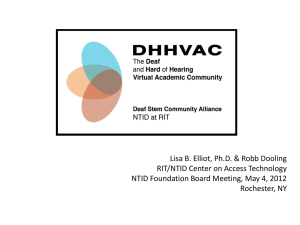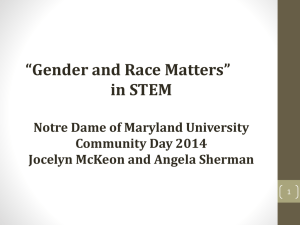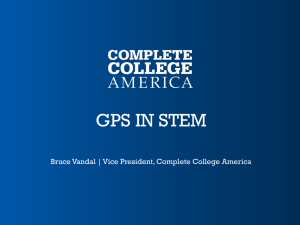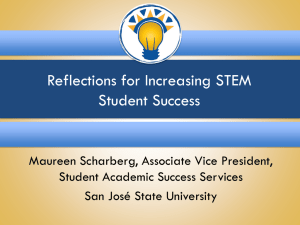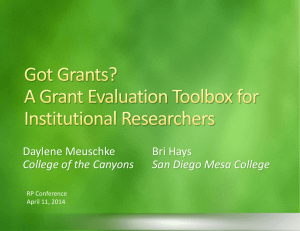Business Engagement Launch
advertisement
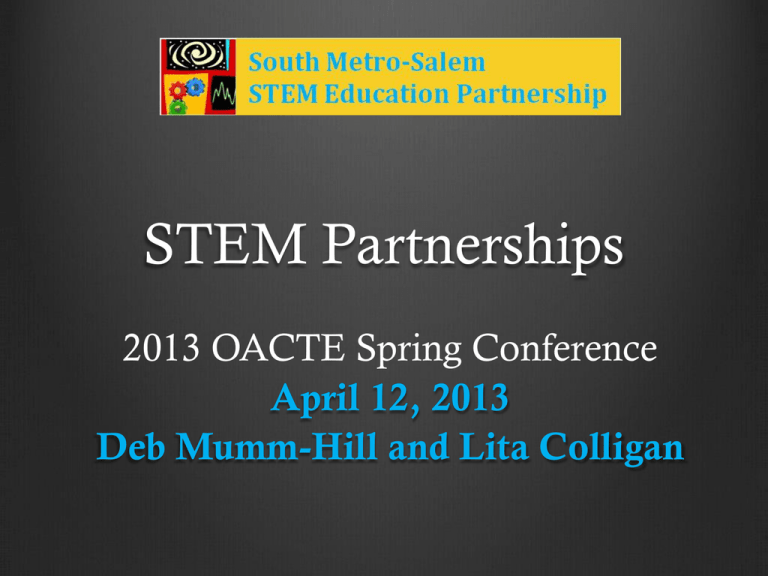
STEM Partnerships 2013 OACTE Spring Conference April 12, 2013 Deb Mumm-Hill and Lita Colligan Presentation Topics: • STEM –What is it? • What’s the need and urgency in Oregon? • How are communities responding? • Tools and resources in your community and in the state? • What do you need to be successful? • Q&A STEM The Oregon Department of Education defines STEM as: “An approach to teaching and lifelong learning that emphasizes the natural interconnectedness of four separate STEM disciplines. The connections are made explicit through collaboration between educators resulting in real and appropriate context built into instruction, curriculum, and assessment. The common element of problem-solving is emphasized across all STEM disciplines allowing students to discover, explore, and apply critical thinking skills.” Definition of STEM: The South Metro-Salem STEM Partners agree that Science, Technology, Engineering, and Math (STEM) fields will be correlated to career opportunities for students in areas such as natural resources, medical sciences, computer science, engineering, life, environmental and physical sciences. National STEM projections Oregon Class of 2006 90% 2.6% 48% 19% Oregon’s TOP science and math graduates from 2006 9% of Graduating Class 1.2% The STEM Gap Oregon is failing to produce enough STEM Graduates Double the number of ALL Oregon graduates earning a STEM degree Double the number of students proficient in Math & Science in 4th and 8th grades Future Workforce Estimated Lifetime Earnings by Education Level 27 percent of people with post-secondary licenses or certificates—credentials short of an associate’s degree—earn more than the average bachelor’s degree recipient (Pathways to Prosperity p. 3). Percentage of Workforce by Education Level 28% 62% Economic Return on STEM Investments +6% Increase in long-run state earnings +$ 9 billion Annual increase in personal income +$1.4 billion Annual increase in state and local government general tax and fee revenue Industry and community partners are the key to education reform Shared Vision and Strategies • Learning community to improve delivery • Connect businesses and community to schools • More dual credit, Advanced Placement and incentives to attract students to STEM Benefits of participation • Increase STEM Workforce – highly educated Oregonians with advanced STEM skills • Enhanced Oregon public education system for our children Oregon Education Investment Board Industry and Community Assets Educators can not do this alone… Differing Perspectives Examples from other nations STEM Task Force Recommendations STEM Council to develop, coordinate, and advance STEM learning and industry engagement in Oregon. STEM Hubs to channel and coordinate community, regional, and state resources for STEM learning. Funding support for STEM students, programs, and teachers. Funding for proper technology infrastructure. Pathways for increasing industry partnership in STEM education. South Metro-Salem STEM Partnership is a perfect example of an emerging STEM Hub. STEM Task Force Recommendations - Statewide STEM Hubs - OEIB’s Proposed STEM Hubs Responsible for organizing and directing STEM operations in a region such as: Operating a regional, flagship, 6-14 STEM Lab school; Centralizing and organizing existing regional work around STEM; Enhancing access to existing regional STEM and CTE facilities and learning opportunities for under-represented students and schools by facilitating inter-district usage and transportation agreements; ands Improving infrastructure, equipment and machinery in existing STEM and CTE facilities to absorb greater numbers of students. Tools We’ve Used • STEM Partnership with regional schools, colleges, universities, out-of-school programs, companies, and community partners to leverage resources • Collective Impact: don’t start from scratch- use what you have • Tour of Superintendents and teachers into companies • Business Outreach Events • Teacher mentorships • Industry Involvement survey How does CTE support STEM education? CTE provides clear pathways to STEM careers helping Oregon meet the 40‐40‐20 goal CTE provides opportunities to learn critical‐thinking and problem‐solving skills within STEM content CTE provides applied learning and high wage, high demand, high skill career preparation in STEM content CTE increases student persistence in STEM education through personal engagement What are you doing now and what help do you need? Questions: What is your school doing now to promote and improve STEM experiences and preparation of students? How does CTE interface with entire school staff ? What’s easy? What works? What excites you? Collective Impact Partnership: It’s a partnership of the willing. • • • • Spread the excitement about STEM Get organized to apply for grants or work on projects Develop a business plan to leverage resources Thank you for coming! Deb Mumm-Hill: deb@oregonfirst.org Lita Colligan: lita.colligan@oit.edu Megan Helzerman: mhelzerman@clackesd.k12.or.us


